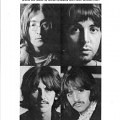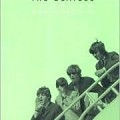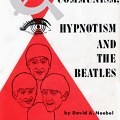- What John Lennon Thinks of Donald Trump - November 14, 2016
- The Meaning of Fun: The Paul is Dead Rumor - February 3, 2016
- BEATLES-STREEP-SHEA SHOCKER: IT’S NOT HER!!!! - August 13, 2015
The two dozen or so films Ringo Starr has made outside of the Beatles may constitute, more than any other legacy, a hefty bequest to the genre known unofficially as film merde. In spite or perhaps because of this, a surprising number of the all-star extravaganzas that make use of our favorite drummer’s amenable presence and recognizable nose have generated cults of some size (at least, if you believe Internet commentators who themselves, rather than stating existing facts, may merely be hoping to originate such cults). If nothing else, some of them offer a window on that passage in cultural history when, thanks in no small part to the Beatles’ influence, certain “underground” sensibilities surfaced and were co-opted as fashionable, potentially lucrative aspects of mainstream entertainment.
Most of these films are embarrassments (not only today: people found them embarrassing at the time). But not every inquiry is about what is good or bad, worthy or wasteful. Sometimes it’s about simply having the experience of a thing that people once found it necessary to create, whatever that thing is.
Whatever it is.
So, as I scrape the merde from my shoes, be diverted by these highlights, offered in chronological order, and in successive posts. (Originally, this was going to be a Top 10 list, but I found that, with Ringo’s movies, that’s simply too much of a stretch.)
CANDY (1968)
Pauline Kael: “It isn’t erotic. It’s a shambles.” That’s like saying Vesuvius wasn’t warm, it was hot. The Christian Marquand-directed adaptation of the Terry Southern-Mason Hoffenberg novel—the cast of which brings together such unlikelies as Marlon Brando, Walter Matthau, James Coburn, Anita Pallenberg, John Huston, and Buck Henry (who also “wrote” the “screenplay”)—somehow leads, among many other places, to the spectacle of our Ringo (as a bug-eyed Mexican gardener torn between evil and purity; that is, between sex and chastity) groping Ewa Aulin’s Candy atop a pool table in a paneled basement rec room somewhere in the American Midwest, as Steppenwolf blares from a jukebox, Richard Burton drunkenly molests a life-size doll, and a nonplussed Sugar Ray Robinson offers voyeuristic commentary from within an aureole of polka dots. Upon climaxing, Ringo howls reverently in memory of a certain legendary Mexican revolutionary leader.














Can’t wait till you get to that culmination of cinema du merde, Caveman (1981), in which a character is literally dropped into a large pile of dinosaur shit.
O, um … SPOILER ALERT! Sorry.
Come to think of it, shit plays a pretty big role in Ringo’s oeuvre, doesn’t it? I mean, not just in the sense that all of his movies could be described as shit, but in the sense that foax in his movies tend to end up neck deep in it, too. A shit-pit looms large in The Magic Christian; and, sad to say, the shit has a much greater acting range than Ringo himself.
But in Ringo’s defense, I’ve never seen shit play drums.
Wait … Does Ted Nugent play drums?
In closing, yes … film merde seems about right.
Wow, that’s unwatchable. Then again, it’s a pretty fair approximation of the book itself, a hipster goof which spiraled ‘way out of control. I can’t lay my hands on my yellowed paperback tie-in edition, but I remember the cover spouting some outlandish sales figure (millions), utterly unjustified by the actual writing. There’s something distinctly naughty-naughty-undergraduate about Candy the book, and I see the movie is, as well. Unlike Lolita and Chatterly, the only point of Candy is to be outrageous (“sex with a HUNCHBACK!”), and that spoils quickly.
Of course Ringo’s awful in that John-Wayne-as-Genghis sort of way, but he’s as much an innocent bystander as one can be while still receiving a check. This is trying to be an updating of the Blake Edwards/What’s New Pussycat? kitchen sink comedy, which never worked after the Summer of Love. Even stuff like I Love You Alice B. Toklas—driven by Peter Sellers, the most popular comic actor of the day—is painful, because the form (old) is pulling against the content (new).
Old showbiz comedy takes place in Unreality—but countercultural comedy was based on a commitment to “relevance,” a kind of truth. This is why something like The Graduate was so lauded at the time, and is still watchable today, whereas The Party, much as I love it, drags like hell. It’s the reality in Dr. Strangelove, not its outrageousness, that makes it a classic. (Kubrick sensed this, which is why he cut the pie-fight scene.)
So there’s a period in film comedy very much like the awkward post-Elvis, pre-Beatles interregnum in rock-and-roll, full of stew-like straining-to-be-hip soundstagey pictures full of stunt casting. I’m thinking of Skidoo, and Head, weird combinations of old show biz gags, shaggy dog bits, and cameos, all filmed in that weird flatly lit TV way; Head looks like an episode of “My Three Sons,” for god’s sake.
In all these movies, celebrity signifiers stand in for actual content. In the trailer to Skidoo, for example, we have Dr. Timothy Leary asking, “Can you imagine Jackie Gleason turned on?” Well, yes I can, and so what?
But maybe that’s the thing to take away: how narrow media was, how little to took to shock, how stable and solid the average conception of reality seems to have been. In 1968, the mere idea of Jackie Gleason—from “The Honeymooners”!—getting high was so outrageous it was considered to be a selling-point for a project. And it was just the idea, because the viewer knew Jackie Gleason wasn’t going to be shown ACTUALLY getting high. Nothing truly surprising or dangerous was going to happen in “Skiddoo” or “Head” or “Candy.” Sammy Davis Jr wasn’t going to be shown ACTUALLY worshipping Satan, as he did briefly during this time, or John Wayne dressing in women’s clothes.
Asking Ringo to be funny under those circumstances is like…well, it’s like Lenny Bruce’s early routines, if you’ve heard those. They’re all impressions of old movie stars and collections of stock showbiz characters; it was only when Bruce revealed his own life and obsessions that his material really connected, and it was only after American movies had dug into the reality of American life—in things like The Graduate, Midnight Cowboy, and The French Connection—that film comedy found its feet again. And the late 60s comedies that do work—I’m thinking The Producers and Take the Money and Run—do so because they exist in a bubble. The old showbiz tropes are an authentic part of a comedian’s persona, not a set of rules external to him/her.
There could’ve been a great, great comedy starring Ringo Starr in 1968, but it would’ve been something like a high-life version of Withnail & I—himself, only heightened; his real life, only funnier; filmed verité, only cleaner. Peter Sellers as a Peter Sellers-type character, convinced he died in 1964 and terrified of the color purple; John as the utter mess he was in ’68; Paul as the lothario and budding magnate; George as the angry guru; and so forth. Ringo’s life was loaded with great comic characters, much better than anything Terry Southern, rooted as he was in that old ’50s reality, could’ve come up with.
Speaking of Skidoo, that’s where the link still above of Groucho Marx as a hookah-huffing holy man comes from.
http://www.youtube.com/watch?v=t66-8QgzmX4
Ray Connolly wrote the screenplay for Ringo’s “That’ll Be The Day” and took the assignment seriously, from what I can tell. David Essex proved he could act, and Ringo wasn’t half bad. Billy Fury plays a character based on Rory Storm.
Michael, I liked your point about the reality of certain films being more important than the reality, and thus the deletion of a pie-fight scene in Dr. Strangelove. Your comment has helped me finally understand why I so dislike the football-game ending of M*A*S*H. We’ve already been persuaded that war is absurd. Why do we a plot-point that is itself absurd? (Another example might be the caricatures in Oliver Stone’s movie “W.” If you want to prove these people did terrible things, let the terrible things speak for themselves. Don’t press the point with crude SNL-type characterizations.)
@Mudarra, I don’t think I understand your first sentence here. Can you clarify?
As to Oliver Stone, I think the unrelenting partisan attacking of JFK damaged him as a filmmaker; the problems with that movie are “baked-in” ones of cinematic necessity (the necessity for a hero/center of the picture, and the necessity of a solution in the final act), but too few people note its incredible strengths. It is Stone’s masterpiece, fast, vast, visually stunning, and coherent, even though the picture it paints is incredibly unpalatable. I believe people 50 years from now will view it much differently, once the political content has been muted by time.
The really interesting thing about JFK is, if you were up on assassination research circa 1992, you could track it, basically scene-by-scene: “And that’s Rose Cheramie’s testimony–and that’s Lee Bowers’–and that’s what Clint Hill told Vince Salandria–” While Stone had to synthesize the mass of information into a watchable, and cinematic, story, most of the time he was simply visualizing research and arranging it. There’s actually a book that goes through JFK noting this, which is a level of historical fidelity that I cannot recall from any other movie.
But Stone was so attacked for this–simply visualizing a lot of information that scholars and journalists had gone out of their way to ignore–that he’s disappeared into cartoonishness ever since. It’s as if he’s trying to give his detractors (and himself) an out; and why wouldn’t he? Who would want to court that psychological pressure? JFK was an experiment for him, an attempt at historical collage; as a work of art he succeeded, but (as with Citizen Kane) the topic was too radioactive for the movie to be judged as a movie–which is the only really fair way to judge it. W. and Nixon fail where JFK succeeded–accidently/on-purpose.